Kirthar Mountains
The Kirthar Mountains (Urdu: كوه کھیرتھر; Sindhi: کير ٿر جبل) are a mountain range that mark the boundary between the Pakistani provinces of Balochistan and Sindh,[1] and which comprise much of the Kirthar National Park. The mountain range forms part of the Kirthar-Sulaiman geologic province,[2] which stretches from the Arabian Sea coast north to the Sulaiman Mountains in northwest Pakistan. The highest peak of the mountains is Zardak Peak at 7,430 ft (2,260 m).[3]
| Kirthar Mountains | |
|---|---|
 Kirthar Mountains Sindh and Balochistan provinces | |
| Highest point | |
| Elevation | 2,260 m (7,410 ft) |
| Coordinates | 27°00′00″N 67°09′20″E |
| Naming | |
| Native name | کير ٿر جبل (Sindhi) كوه کیر تھر (Urdu) |
| Geography | |
| Location | Sindh and Balochistan provinces |
Geography
The mountains extend southward for about 190 mi (310 km) from the Mula River in east-central Balochistan to Cape Monze on the Arabian Sea. In total, the Kirthars cover an area of about 9,000 square kilometers.[4] The Khasa Hills and Mulri Hills close to the Arabian Sea coast are sub-ranges of the Kirthar Mountains which extend into the city limits of Karachi. The mountains are drained by the Gaj River and Hub River.
Mountain peaks
The highest peak of the mountains is Zardak Peak at 7,430 ft (2,260 m).[3] The second tallest, Barugh Hill, has a height that was reported in April 2009 as 7,056 ft (2,151 m),[5] although the British Army Corps of Engineers l surveyed it as 7,122 ft (2,171 m). Barugh Hill is the highest mountain in the Sindh portion of the Kirthars.[5] Barugh, means "big fat mountain" in the Brahui language, the language of the Sasoli tribe, who still live in the area. Barugh Hill is situated a few miles north-west of the Gorakh Hill Station, which is situated at an elevation of 5,688 ft (1,734 m).
The next highest peak is the 6,880-foot-tall (2,100 m) mountain Kutte-Ji-Kabar (Sindhi for "Dog's Grave"), also known as Kuchak-na-Kabar in Brahui.[6][7] The mountain is located in a region claimed by the provincial governments of Sindh and Balochistan.[8] As recored in Folk Tales of Scinde and Guzerat (circa 1855),[6] the mountain is named for a story in which a Brahui man is forced to leave his dog as collateral to a wealthy Hindu merchant in order to settle his debts.[9] According to the tale, the dog chased after thieves who had stolen from the merchant, leading the merchant to free him and return to his master. The Brahui man thought the dog escaped and so was angry with the dog for his disobedience. The rejected dog died, and when the Brahui man came to learn of the true story, he felt remorseful and climbed to the top of the mountain in order to bury his dog.[10]
Other peaks include the Andraj Mountain at 6,496 ft (1,980 m).[11] There are also a number of other peaks of the Kirthar Mountains exceeding 5,500 ft (1,700 m), which all receive occasional snowfall during the winter season. To the south the mountains decrease in size towards Bedor Hill, with a height of 3,320 ft (1,010 m).
Geology
The Kirthars consist of a series of parallel rock hill ridges oriented mostly north-south,[4] with piedmont and piedmont-alluvial plains located between ridges, with dry riverbeds.[4] The ridges rise rapidly over short distances between valleys and ridges.[4] From the Arabian Sea coast, they rise to nearly 8,000 ft (2,400 m) in the north.[12]
The Kirthars are part of the Kirthar-Sulaiman geologic province,[2] which stretches from the Arabian Sea coast north to northwestern Pakistan along the western boundary of the Indus Valley. The upper portions of the mountains are largely limestone, while the middle and southern portions of the mountain are shale which date to the middle Eocene era.[13]
Settlement
Within the Kirthar Mountains are 21 prehistoric sites.[4] The 16th-18th century Taung Tombs are also located in the range. There are 71 tombs which situated in the area of the Chhuttas tribe. The inhabitants of the Kirthar Mountains are chiefly Chhutto people of Bhootani tribe, and various Sindhi and Balochi tribes who subsist by flock grazing.[14] Major Baloch tribes living in the Kirthars are Chhutta, Burfat, Gabol, Marri, Bozdar, Lund, Nohani, Bugti, Chandio, and Lashari.
Gallery
 Cold water spring in the Kirthar National Park
Cold water spring in the Kirthar National Park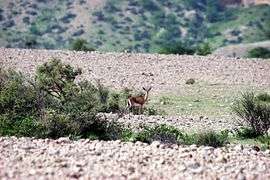 Chinkara gazelle in the Kirthar Mountains
Chinkara gazelle in the Kirthar Mountains Another view of the Kirthar National Park
Another view of the Kirthar National Park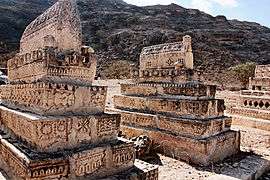 The Taung Tombs
The Taung Tombs Spring of Piprasar in Kirthar Mountain
Spring of Piprasar in Kirthar Mountain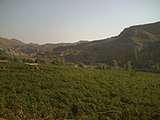 Agricultural vale in Kirthar Mountain
Agricultural vale in Kirthar Mountain A cave near water spring in Kirthar Mountain
A cave near water spring in Kirthar Mountain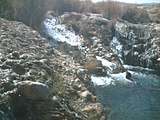 Water fall in the Kirthar Mountain
Water fall in the Kirthar Mountain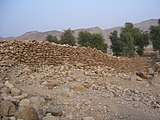 A wall of oldest fort in the Kirthar Mountain
A wall of oldest fort in the Kirthar Mountain A kind of flowery plant in Kirthar mountain
A kind of flowery plant in Kirthar mountain_plant_in_Kirthar_Mountain.jpg) Senwar (in Sindhi) plant in Kirthar Mountain
Senwar (in Sindhi) plant in Kirthar Mountain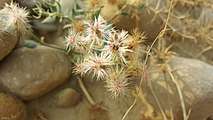 A thorny plant in Kirthar Mountain
A thorny plant in Kirthar Mountain The "Dog's Grave" at Kutte-ji-Qabar
The "Dog's Grave" at Kutte-ji-Qabar
References
- Abraham, Shinu Anna; Gullapalli, Praveena; Raczek, Teresa P.; Rizvi, Uzma Z. (2016-06-16). Connections and Complexity: New Approaches to the Archaeology of South Asia. Routledge. ISBN 978-1-315-43184-0.
- Sembar Goru Ghazij composite total petroleum system, Indus and Sulaiman-Kirthar geologic provinces, Pakistan and India. DIANE Publishing. ISBN 978-1-4289-8458-5.
- India, Imperial gazetteer of; Hughes-Buller, Ralph Buller (1908). Provincial Series: Baluchistan. Superintendent of government printing. p. 93.
- Abraham, Shinu Anna; Gullapalli, Praveena; Raczek, Teresa P.; Rizvi, Uzma Z. (2016-06-16). Connections and Complexity: New Approaches to the Archaeology of South Asia. Routledge. ISBN 978-1-315-43184-0.
- "Geography: Mountains of Pakistan". DAWN.COM. 2009-09-05. Retrieved 2020-04-20.
- Tribune.com.pk (2011-12-02). "The dog's grave". The Express Tribune. Retrieved 2020-04-20.
- "Sindh rejects Balochistan's claim on mineral-rich land in Kirthar mountains". www.thenews.com.pk. Retrieved 2020-04-20.
- Tribune.com.pk (2018-03-29). "Sindh, Balochistan govt at loggerheads over peak in Kirthar mountains". The Express Tribune. Retrieved 2020-04-19.
- "Kutte ji Kabar: a celebration of loyalty". Daily Times. 2019-06-17. Retrieved 2020-04-20.
It came to the attention of a wealthy Hindu merchant, one of whose debtors was the poor Brohi. One day, the merchant asked him to leave the dog at his shop until the payment of his debts.
- "Kutte ji Kabar: a celebration of loyalty". Daily Times. 2019-06-17. Retrieved 2020-04-20.
- Organisation (Pakistan), Population Census; Organisation (Pakistan), Population Census (2001). 1998 Provincial Census Report of [name of Province].: Balochistan. Population Census Organization, Statistics Division, Govt. of Pakistan.
- "Kirthar Range - mountain region, Pakistan".
- Kobayashi, Teiichi; Toriyama, Ryuzo (1980). Geology and Palaeontology of Southeast Asia. University of Tokyo Press. ISBN 978-0-86008-263-7.
- "Kīrthar Range | mountain region, Pakistan". Encyclopedia Britannica. Retrieved 2020-04-19.